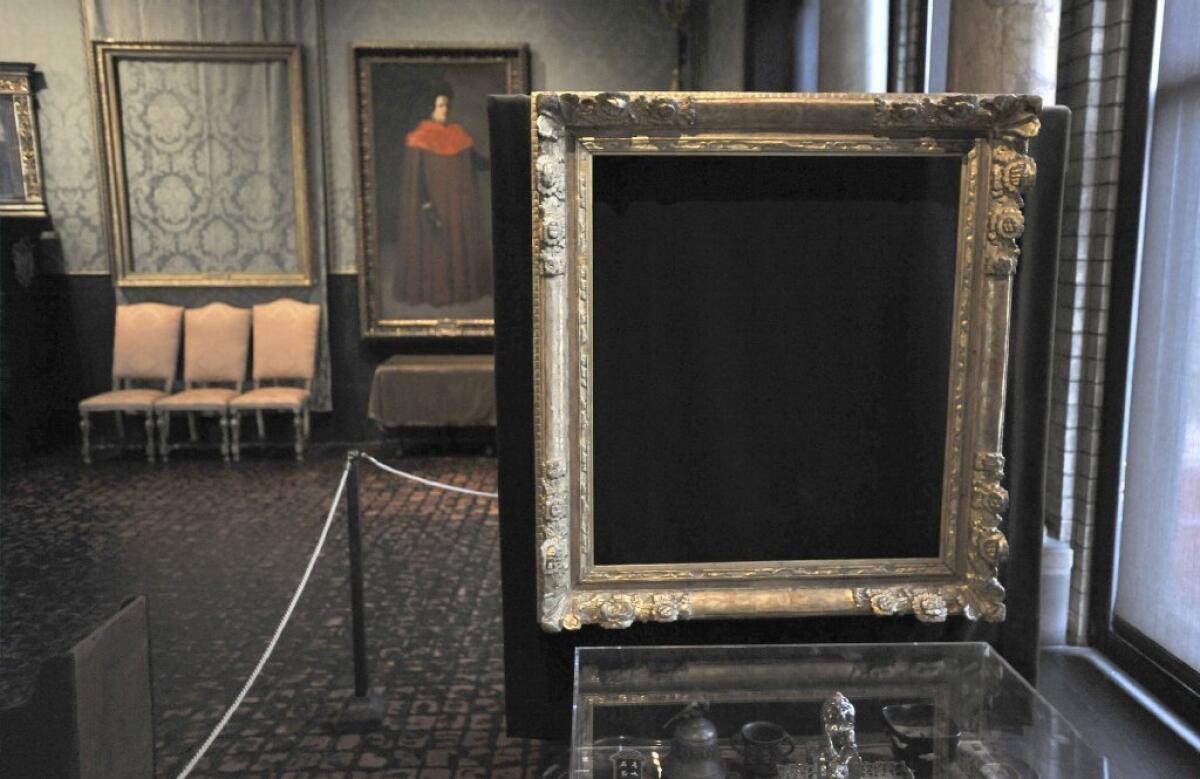FBI says it knows who pulled off unsolved 1990 Boston art heist

As far as crimes go, the heist itself was a work of art.
On March 18, 1990, two men in police uniforms talked their way into the Isabella Stewart Gardner Museum in Boston, where they tied up the security guards. After disabling the security cameras, they proceeded to make off with 13 works valued at $500 million.
The theft has flummoxed investigators for 23 years -- a streak the Federal Bureau of Investigation is now asking the public to help break.
On Monday, officials revealed that they think they know the identities of the two men who took the art -- which included works by Rembrandt, Vermeer and Degas -- and that the art may still be in the Northeast.
“The FBI believes with a high degree of confidence that in the years after the theft, the art was transported to Connecticut and the Philadelphia region, and some of the art was taken to Philadelphia, where it was offered for sale by those responsible for the theft,” Richard DesLauriers, special agent in charge of the FBI’s Boston office, said in a statement Monday. “With that same confidence, we have identified the thieves, who are members of a criminal organization with a base in the mid-Atlantic states and New England.”
The new details are part of a publicity push by federal officials to raise awareness about the missing paintings, whose return could bring a $5 million reward from the museum and the possibility of immunity from federal prosecution.
Officials would not release the names of the suspects, and Carmen Ortiz, U.S. attorney for Massachusetts, said the statute of limitations for the theft had expired. Ortiz did not promise immunity for return of the paintings but suggested that, under certain conditions, it might be a possibility.
“The key goal here is to recover those paintings and bring them back,” she said.
The enigmatic nature of the case stems in part from the enigmatic character of the museum’s founder. Isabella Stewart Gardner, who was born in 1840, was an eclectic socialite and an aesthete, once writing that her biggest concern was “seeing and doing only what is beautiful.”
With a large inheritance from her father, Gardner collected works by Renaissance masters and built a museum to hold them. When she died, she left a will that contained a kind of legal suicide bomb for the museum: If any of her trustees changed the art, the whole museum would be turned over to Harvard for liquidation.
That provision meant that, after the theft, the places where the paintings were hung remained blank -- leaving only frames where masterworks used to be.
“Over the past three years, I have visited the museum several times, and each time I entered the Dutch Room and saw the empty frames, I was reminded of the enormous impact of this theft,” Ortiz said in a statement. “I do remain optimistic that one day soon the paintings will be returned to their rightful place in the Fenway [neighborhood], as Mrs. Gardner intended.”
The theft presents a unique challenge for black-market sellers because the value of the works lies both in being one-of-a-kind and easily recognizable -- a value that makes a loss particularly painful for a museum.
“Imagine never hearing Beethoven’s Fifth Symphony again, or never seeing ‘Hamlet’ again,” Anthony Amore, the museum’s chief of security, said at a news conference.
Art trafficking, much as the art market itself, can still be incredibly lucrative for those who participate in it, with the U.S. Department of Justice estimating that global art trafficking grosses only less than the drugs and arms trades.
[For the Record, 3:53 p.m. March 18: An earlier version of this post identified Carmen Ortiz, the U.S. attorney for Massachusetts, as Cindy Ortiz. 12:11 p.m. March 19: An earlier version of this post quoted Carmen Ortiz as referring to Fenway Court, the former name of the Isabella Stewart Gardner Museum. Actually, Ortiz was referring to the Fenway neighborhood of Boston.]
ALSO:
Girl Scout cookie thieves target thin mints, cash boxes
2 Ohio teens sentenced for rape; defendants apologize, lawyers weep
Victim’s mother in Steubenville rape speaks after conviction of 2 youths
More to Read
Sign up for Essential California
The most important California stories and recommendations in your inbox every morning.
You may occasionally receive promotional content from the Los Angeles Times.











